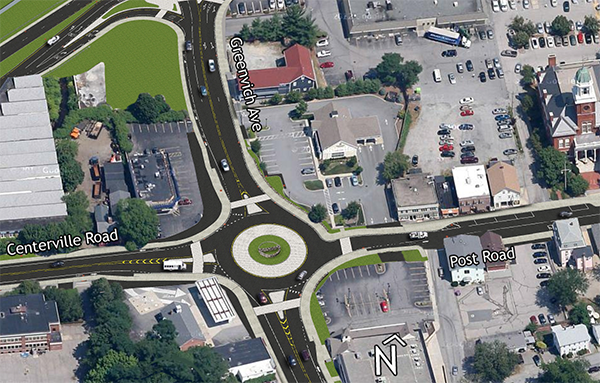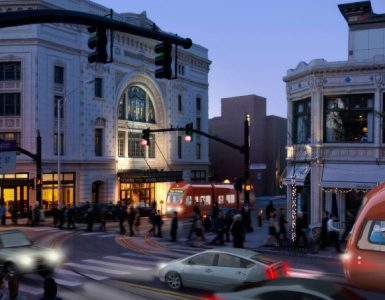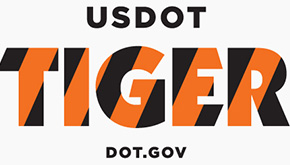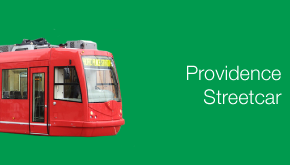The Providence streetcar project is not the only TIGER grant application coming from Rhode Island. RIDOT has also submitted an application for the Apponaug Circulator Long-term Improvements Project .
The Mayor has thrown his support behind the streetcar however the Governor (former Mayor of Warwick) is not on board, saying through a spokesperson to WPRI that the streetcar project is, “not ready to go.”
I contend that it is the Apponaug project is not ready to go, here’s why:

RIDOT rendering of Four Corners in Apponaug.
1. 20th century traffic solutions
The one-way circulation as it exists today was a temporary response to the construction of the Post Road Extension by-pass built in the 1970’s. High-speed traffic from that bypass was dumped into the one-way circulation to reach Routes 117 and 1 at the southern side of Apponaug.
The current circulator project seeks to relieve problems cause by heavy through traffic and fix “numerous roadway deficiencies [that] exist along all legs the circulator, including narrow lane widths, narrow or nonexistent shoulder widths, insufficient horizontal curves, poor curb reveal, and poorly defined curb openings.” At the same time, it seeks to improve the environment for area businesses, pedestrians, and cyclists.
These wide lanes, wide shoulders, broad curves, and etc. are exactly what make a village center environment such as Apponaug a poor place for pedestrians and cyclists and by extension, a poor place to run a business. This kind of engineering perpetuates the high-speed movement of automobiles and will not help get pass-through traffic to stop and patronize area businesses.
Basically, these conditions extend the road environment of the Post Road Extension straight through Apponaug.
2. Walkability
While the plan calls for reducing the section of Post Road between Four Corners and Williams Corner, the main historic business district, to one lane and installing curb extensions leading to raised crosswalks through that section, the rest of the roadways through the project feature four-lane arterials with wide shoulders; not an ideal environment for pedestrians.
The project features four roundabouts and one tear-shaped not quite roundabout at Williams Corner. While the proposal claims that, “A key characteristic of roundabouts is their ability to handle pedestrian crossings safely,” I’m dubious about the safety of pedestrians in any roundabout that has two-lanes of high-speed traffic moving in each direction. ‘Yield to pedestrians’ and speed limit signs can be put up all over the place, but traffic will move at the speed the road is engineered to allow it to move at.
The business district portion has good pedestrian enhancements, the rest of the project area is not ideal and continues to cut pedestrians off from the surrounding areas.
3. Bicycles
The section of Post Road through the Business District which is getting the good pedestrian enhancements also has a bike lane. A one-way bike lane from Four Corners to Williams Corner. So one could put their bike on their car, drive to Four Corners, and ride it to Williams Corner, but they would not be able to ride their bike back to their car as there is no other bicycle infrastructure to make the return trip, or a trip anywhere else. Oh wait, RIDOT actually says that the remaining roadways will have “bicycle tolerant shoulders,” also known as glass and road salt storage basins. Yay!
The City of Warwick hopes to make the area around the Airport and the Interlink into a new business district, bike lanes along Jefferson Blvd. to Post Road and through Apponaug would be a worthy and inexpensive investment for this, especially as Apponaug is planned to be completely rebuilt now. Why stop at “bicycle tolerant shoulders” when a couple more feet of pavement could result in real bike lanes and cycle tracks.
4. Bypassing the Bypass
The plan calls for the construction of a new bypass road, and extension of Veterans Memorial Drive from that road’s intersection with Greenwich Ave./Route 5 to the intersection of Centerville Road/Route 117 and Toll Gate Road/Route 115. This bypass will feed traffic directly from the Post Road Extension to Centerville and Toll Gate Roads without traffic having to go through Apponaug.
There’s a number of problems with this. First, if Greenwich Ave. north of Four Corners and Veterans Memorial Drive each become two-way roads, then they in effect become the bypass of Apponaug, so we’re building a bypass of a bypass? Sure, traffic from the west still has to contend with Four Corners, but that is supposed to be solved with the construction of the roundabout at that location.
Furthermore, if we’re encouraging all traffic to bypass the Apponaug Business District (at least the historic heart of it along Post Road), then how does that help the local businesses, one of the stated goals of the project. Taking the passing traffic and moving it away so it doesn’t know you’re there seems less than helpful.
For a real world example of what a bypassed business district looks like, see Buzzards Bay, Massachusetts.
For generations, the Main Street in Buzzards Bay was the way people from points south and west (New Yorkers mainly) reached Cape Cod. In the late 1980’s Route 25 was completed connecting I-495 to the base of the Bourne Bridge. All the traffic in Buzzards Bay went away, the business dried up, and town fathers have been trying to revitalize the area ever since.
Also…
5. The Environment
A large part of the Circulator proposal deals with area storm water runoff. The bypass road is set to be routed through the site of an old mill complex where a stretch of the Apponaug River has been culverted under ground (historically this provided power to the mills). The site of this former mill is subjected to flooding, restoration of the Apponaug River and other wetlands restoration will mitigate that.
However, building the bypass road creates more impervious surface that the restoration efforts will have to mitigate. Not building the bypass and allowing the mill site to become open space will help reduce the amount of runoff that needs to be dealt with, while also creating open space for area residents, business customers, and wildlife to enjoy.
The proposal also claims that moving traffic more efficiently through Apponaug will reduce vehicle emissions…
6. If you build it, they will come
If traffic counts remained the same, then yes, moving that traffic more efficiently with less stopping would reduce emissions, idling cars not moving are doing nothing but spewing toxins into the air.
However, it is shown time and again, that if you increase traffic flow and mitigate congestion, more traffic will come to fill that new capacity, we call this induced demand. When people find out the traffic at Four Corners is moving better, people who currently find ways to avoid the area will change their behaviors and use the roadway, increasing traffic counts and erasing air quality gains.
The lack of adequate bike infrastructure and no planing for public transit (the word RIPTA does not appear in the proposal), mean that Apponaug will continue to be a primarily automobile dominated environment. If the current traffic volume is inadequate to support local businesses, and helping local businesses is one of the justifications for the plan, then we will need more cars coming to the area if we hope to see more patrons for those businesses.
7. City vs. Suburb
If this proposal were on its own in a vacuum, I would still say it is not ready yet do to all the reasons listed above. But this also happens to be in direct competition with Providence’s application for TIGER funds for the streetcar. For the Governor to say that the streetcar is not ready but insist that this is, pits city vs. suburb.
The current condition of Apponaug is a problem, and it needs fixing, but RIDOT is trying to engineer their way out of a traffic problem by adding capacity and building road geometries to increase speed and through-put of cars, a decidedly suburban solution to the issues at hand. In truth, Apponaug is a little tiny urban remnant destroyed by prioritization of the automobile above place. This area needs an urban solution.
Warwick is a city with declining population, not building this right perpetuates the city’s problems and does not prepare it for the 21st century, where more and more people are not driving. Providence’s proposal supports the economic heart of our state with a proposal that builds upon the city’s urbanity and prepares it for the 21st century.
I look at this proposal and I see shades of America’s Cup Blvd. in Newport, a 20th century mistake that city is trying to undo.
8. Return on investment
As we have a situation now where this project is pitted against the streetcar, we have to compare returns on investment. The streetcar is set to be a catalyst for development in the capital city of our state.
The Apponaug project’s economic advantages are, “Significant benefits in travel time and reliability cost savings, with the bypass and related improvements being critical to the economic revitalization of the Apponaug Business District, a long-declining urban center and key transportation node in the Economically Distressed region.”
Apponaug needs help, but pitting a small suburban village in a declining city versus the economic impact development in Providence has on the entire state is foolhardy. As far as these federal funds go, this is an either/or proposition. There are $474 million in TIGER funding available, and there have been $9 billion (with a ‘B’) in requests. It is unfortunate that our Governor insists this project is the one that’s ready and creates the appearance of discord within the state, endangering our chances of receiving any TIGER funds.
9. Politics
Gov. Chafee, who supports Apponaug’s bid (who is also the former Mayor of Warwick, in case he let you forget) will almost certainly be facing Mayor Taveras in the Democratic Primary for Governor next fall. Is the Governor ceding Providence to the Mayor and going for the suburban vote by supporting a road building project in the suburbs over a public transit project in the City? Is the Governor supporting this project to deny the Mayor a big win with the streetcar before they face off? Maybe?
10. Phase II?
The streetcar project is the potential nexus of an entire streetcar system. When then Mayor Cicilline proposed it, he had a vision for streetcars criss-crossing the region and extending into neighboring cities (even Warwick). The Apponaug project..? That’s it, there is no phase II, it is not the embryo of a larger economic and transportation plan.
If the Apponaug project is what sits between us and federal funds for a Providence streetcar, then it should be the Apponaug project that has to wait. Designed properly, the Apponaug project could cost less, have a bigger economic impact on Warwick, and be a model for the 21st century revitalization of other villages in that city.
In my opinion, as it stands now, the Apponaug project is not ready to go.





But when you compare the impacts Apponaug and Providence have on our state as a whole, can you REALLY say that Providence should take priority here?
The guvner should be tarred and feathered for myopia and stupidity.
Rotaries aren’t even examples of good auto-oriented road design, no matter what new spin (ha!) or fancy name you attach to them.
In fact, they’re actually an example of extremely bad auto-oriented road design (actually, strike the auto focus, they’re just plain bad road design) masquerading as good road design. The only time they’re truly appropriate is when you have five or more directions of traffic coming together and can’t find some way to reduce the intersection down to groups of separated three-way and four-way intersections. In all other cases, a signalized intersection is strictly better for every mode – drivers, pedestrians and bicyclists all benefit from replacing circles with signals.
For an example of the pedestrian-friendly attitude of RIDoT take a walk up Point Street and figure your way across the I-95 bridge — the heavily used pedestrian path from the Coro Center to the Hospitals.
Sorry to disagree with Ryan whom I usually agree with, but I think roundabouts, if done right, are a really good thing, much better than the interminable waits on 4-phase traffic lights or having to make dangerous left turns onto oncoming traffic. Roundabouts slow all traffic, good for bikes/pedestrians, but usually do not stop traffic, saving time, fuel, and benefitting the environment nearby. They avoid that dangerous excessive speeding up to make a green light. We do need a critical mass of them so that all get used to the yield-on-enter system. Those who have driven in Europe where roundabouts are so frequent know the system works, and as tourists also helps us make easy u-turns if we miss a turnoff. We also get to see a lot of imaginative sculptures or plantings in the center isalnd.
The rotary at Connell Highway and Admiral Kalbus Blvd. in Newport was recently modified to “modern roundabout” standards. It took a while for drivers to adjust to it. The new configuration works well. Traffic has significantly slowed down though movement through the rotary is much better. Visibility to enter the rotary is improved, as the yield position from entering streets is closer, so it’s easier now to judge when to enter compared with the old configuration. Having not walked around the rotary, I don’t know if it’s better or worse from a pedestrian standpoint.
In my opinion rotaries or roundabouts are preferable to traffic signals as waiting times reduced dramatically or eliminated. RIDOT still owns the old rotary right-of-ways at Route 2 and 102 just before Exeter, and at Route 2 and 138 near West Kingston. It would be great if they replaced the signals and rebuilt the rotaries to current modern standards.
Roundabouts are good road design, for drivers. For pedestrians, they might be a bit safer but no pleasanter than the alternative. Traffic careens and you best assume drivers are watching for their chance to gun it and merge, not for you. And two lane roundabouts? Sheesh. It is ridiculous to claim this plan could make even a single person likelier than now to walk from some other part of Warwick to Apponaug.
BTW, what is the need of of the Post Road Extension? Any time I have ever driven there mine was the only car except for knuckleheads using the wide open straightaway to see how fast they can go. Remove it.
If we assume that good road design for automobiles prioritizes the fast and efficient movement of vehicles, then roundabouts are a bad example of such designs because while “all traffic moves through slowly” seems like an efficiency win over having cars stopped at a light, in actuality, “well-timed” (for drivers) and coordinated signalization taking advantages of concepts like the green wave will move more vehicles than the roundabout equivalent. Furthermore, good “modern” roundabout design doesn’t permit vehicular speeds of faster than 20 mph, which means a critical mass of roundabouts on any given roadway (say, Route 2) will do a fantastic job of ensuring that no vehicle can really move faster than a 25 mph average – “gunning it” out of the roundabout will be met by heavy breaking in time for the next roundabout. This directly conflicts with the principal goal of auto-focused road design – moving cars quickly.
But lest you think that means roundabouts are a big win for pedestrians – think again. Leaving aside the fact that a roundabout explicitly prohibits pedestrians from entering it to walk directly across, good “modern” roundabouts are never signalized at any point. This means that the pedestrian loses both the relative safety of the “pedestrian” traffic light phase(s) and the ability to signal a pedestrian phase and halt traffic before crossing. This means that pedestrians must cross without any real protection or even warning that a pedestrian is there – while yield instructions are great for stopping drivers prior to entering the roundabout and allowing pedestrians to cross one half of the street, the “slow but constant movement” characteristics of roundabouts mean that all the signage in the world instructing drivers to yield to pedestrians when exiting the roundabout won’t matter because the expectation – enforced by the engineering – is that a driver exiting the roundabout Will Not Need To Stop. Even defensive drivers extremely mindful of pedestrian presence will not be anticipating a need to stop after clearing the roundabout, increasing the risk of collision and the number of times drivers may need to “slam the brakes.” So, the roundabout is bad road design for pedestrian-focused roads as well as for auto-focused roads. And, of course, the easiest and most effective way to mitigate this increased pedestrian risk is through signalization – the very instrument that roundabouts seek to avoid.
Through proper timing and signal coordination, we can get the slowed traffic benefits of a “critical mass” of roundabouts by having a string of several lights change from red to green in a “green wave” timed for traffic moving at 25, 20, or even 15 mph – cars attempting to accelerate past that speed will simply keep hitting red light after red light, having outpaced the “green wave,” and the use of signals continues to provide for enhanced pedestrian safety through protected pedestrian walk phases and through providing pedestrians with an option to call for a halt to traffic as well.
Providence Business News: Streetcars or funding for village?
Warwick Beacon: Roundabouts to put more spin on Apponaug traffic
ProJo: $33.5M plan to unsnarl traffic in Warwick village of Apponaug will also unearth a river
A meadow with a four-lane divided-highway running through it does not ‘an awfully good songbird habitat’ make. I don’t know why the DEM thinks otherwise.
Has anyone here actually driven the Apponaug roundabouts? They are very poorly designed. There is more room given to pedestrian walkways and islands than for traffic. The “curbs” that will separate the two directions of traffic are placed poorly for people to get in and out of places like the Dunkin Donuts, the liquor store, even the firehouse!
For example in order for someone to get to the Dunkin Donuts/Liquor Store/Pizzaria plaza, they will have to stop traffic traveling West onMemorial Blvd and wait for a break in two lanes of traffic going the other way, and the opening in the median (at least as it is now) is VERY sharp!